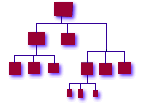


|

|
|
home | sitemap | abstract | introduction | chaos | thinking | checklist | migrating | recovery pushpull | cost | career | workshop | isconf | list_and_community | papers | references |
Network File ServersPrerequisites: Directory Servers, Authentication Servers, Time Synchronization We kept our file servers as generic and identical to each other as possible. There was little if any difference between a client and server install image. This enabled simple recovery. We generally used external hardware RAID arrays on our file servers. We often used High-Availability NFS servers [blide] . We preferred Samba [samba] when serving the same file shares to both UNIX and Windows NT clients. We were never happy with any "corporate" backup solutions -- the only solution we've ever come close to being satisfied with on a regular basis is Amanda [amanda] . The networked UNIX filesystem has been reinvented a few times. In addition to NFS we have AFS, DFS, and CacheFS, to name a few. Of these, only NFS was available on all of our client platforms, so for us it was still the best choice. We might have been able to use AFS in most cases, but the expense, complexity, and unusual permissions structure of AFS were obstacles to its implementation. And if AFS is complex, then DFS is even more so. One interesting network filesystem is Coda [coda], though it looks like its successor InterMezzo [intermezzo] is less complex and heavyweight. Currently under development but already publicly available, these non-proprietary caching filesystems are freely available, and already ported to many operating systems, including Linux. They support disconnected operation, replicated servers, and Coda supports Kerberos authentication. These features when added together may make them worth the complexity of implementation. An open-source implementation of CacheFS would also be good. As mentioned before, we kept the disk image differences between a desktop client and an NFS server to a minimum. With few exceptions, the only differences between a desktop and server machine were whether it had external disks attached and the speed and number of processors. This made maintenance easy, and it also made disaster recovery simple. |
|
||||||||
|
© Copyright 1994-2007 Steve
Traugott,
Joel Huddleston,
Joyce Cao Traugott
In partnership with TerraLuna, LLC and CD International |
||||||||